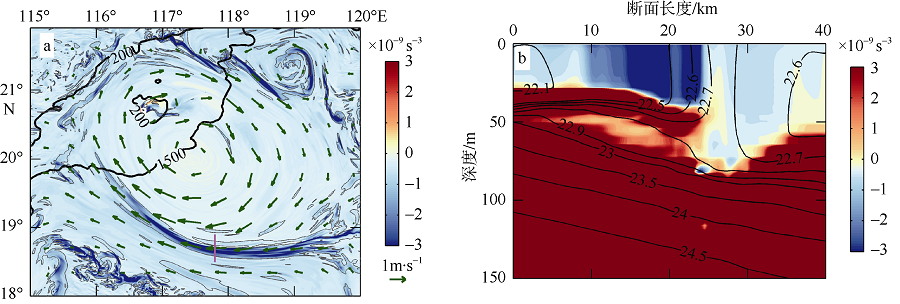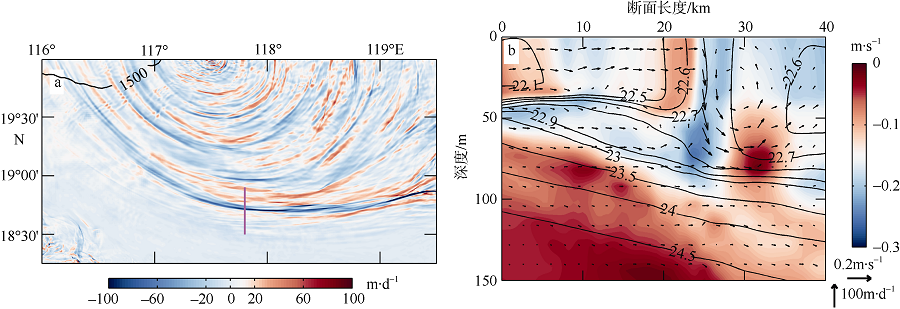| [1] |
冀承振, 叶瑞杰, 董济海, 等, 2017. 南海中尺度涡边缘亚中尺度过程模式研究[J]. 中国海洋大学学报, 47(1): 1-6.
|
|
JI CHENGZHEN, YE RUIJIE, DONG JIHAI, et al, 2017. The simulation of submesoscale process at the periphery of a mesoscale eddy in the South China Sea[J]. Periodical of Ocean University of China, 47(1): 1-6 (in Chinese).
|
| [2] |
刘国强, 2011. 南海北部以及吕宋海峡次级中尺度动力过程数值模拟研究[D]. 青岛: 中国科学院研究生院(海洋研究所): 131.
|
|
LIU GUOQIANG, 2011. Numerical study of submesoscale processes in northern South China Sea and Luzon Strait[D]. Qingdao: Graduate University of Chinese Academy of Sciences (Institute of Oceanology, Chinese Academy of Sciences): 131 (in Chinese).
|
| [3] |
罗士浩, 经志友, 齐义泉, 等, 2016. 南海北部次中尺度过程数值研究[J]. 热带海洋学报, 35(5): 10-19.
|
|
LUO SHIHAO, JING ZHIYOU, QI YIQUAN, et al, 2016. Numerical study on sub-mesoscale processes in the northern South China Sea[J]. Journal of Tropical Oceanography, 35(5): 10-19 (in Chinese).
|
| [4] |
BACHMAN S D, FOX-KEMPER B, TAYLOR J R, et al, 2017. Parameterization of frontal symmetric instabilities. I: Theory for resolved fronts[J]. Ocean Modelling, 109: 72-95.
|
| [5] |
BOCCALETTI G, FERRARI R, FOX-KEMPER B, 2007. Mixed layer instabilities and restratification[J]. Journal of Physical Oceanography, 37(9): 2228-2250.
|
| [6] |
BRANNIGAN L, 2016. Intense submesoscale upwelling in anticyclonic eddies[J]. Geophysical Research Letters, 43(7): 3360-3369.
|
| [7] |
CAPET X, MCWILLIAMS J C, MOLEMAKER M J, et al, 2008a. Mesoscale to submesoscale transition in the California current system. Part II: Frontal processes[J]. Journal of Physical Oceanography, 38(1): 44-64.
|
| [8] |
CAPET X, MCWILLIAMS J C, MOLEMAKER M J, et al, 2008b. Mesoscale to submesoscale transition in the California current system. Part III: Energy balance and flux[J]. Journal of Physical Oceanography, 38(10): 2256-2269.
|
| [9] |
CHEN GENGXIN, HOU YIJUN, CHU XIAOQINGet al, 2009. The variability of eddy kinetic energy in the South China Sea deduced from satellite altimeter data[J]. Chinese Journal of Oceanology and Limnology, 27(4): 943-954.
|
| [10] |
D'ASARO E, LEE C, RAINVILLE L, et al, 2011. Enhanced turbulence and energy dissipation at ocean fronts[J]. Science, 332(6027): 318-322.
|
| [11] |
DU YUNYAN, WU DI, LIANG FUYUANet al, 2016. Major migration corridors of mesoscale ocean eddies in the South China Sea from 1992 to 2012[J]. Journal of Marine Systems, 158: 173-181.
|
| [12] |
FOX-KEMPER B, FERRARI R, HALLBERG R, 2008. Parameterization of mixed layer eddies. Part I: Theory and diagnosis[J]. Journal of Physical Oceanography, 38(6): 1145-1165.
|
| [13] |
GULA J, MOLEMAKER M J, MCWILLIAMS J C, 2014. Submesoscale cold filaments in the gulf stream[J]. Journal of Physical Oceanography, 44(10): 2617-2643.
|
| [14] |
GULA J, MOLEMAKER M J, MCWILLIAMS J C, 2016. Submesoscale Dynamics of a gulf stream frontal eddy in the South Atlantic bight[J]. Journal of Physical Oceanography, 46(1): 305-325.
|
| [15] |
HAINE T W N, MARSHALL J, 1998. Gravitational, symmetric, and baroclinic instability of the ocean mixed layer[J]. Journal of Physical Oceanography, 28(4): 634-658.
|
| [16] |
HANEY S, FOX-KEMPER B, JULIEN K, et al, 2015. Symmetric and geostrophic instabilities in the wave-forced ocean mixed layer[J]. Journal of Physical Oceanography, 45(12): 3033-3056.
|
| [17] |
HOLMES R M, THOMAS L N, THOMPSON L, et al, 2014. Potential vorticity dynamics of tropical instability vortices[J]. Journal of Physical Oceanography, 44(3): 995-1011.
|
| [18] |
HOSKINS B J, 1974. The role of potential vorticity in symmetric stability and instability[J]. Quarterly Journal of the Royal Meteorological Society, 100(425): 480-482.
|
| [19] |
JING ZHIYOU, QI YIQUAN, DU YAN, et al, 2015. Summer upwelling and thermal fronts in the northwestern South China Sea: Observational analysis of two mesoscale mapping surveys[J]. Journal of Geophysical Research: Oceans, 120(3): 1993-2006.
|
| [20] |
JING ZHIYOU, QI YIQUAN, FOX-KEMPER B, et al, 2016. Seasonal thermal fronts on the northern South China Sea shelf: Satellite measurements and three repeated field surveys[J]. Journal of Geophysical Research: Oceans, 121(3): 1914-1930.
|
| [21] |
JOYCE T M, TOOLE J M, KLEIN P, et al, 2013. A near-inertial mode observed within a Gulf Stream warm-core ring[J]. Journal of Geophysical Research: Oceans, 118(4): 1797-1806.
|
| [22] |
LÉVY M, KLEIN P, TREGUIER A M, 2001. Impact of sub-mesoscale physics on production and subduction of phytoplankton in an oligotrophic regime[J]. Journal of Marine Research, 59(4): 535-565.
|
| [23] |
LIU F, TANG S, CHEN C, 2015. Satellite observations of the small-scale cyclonic eddies in the western South China Sea[J]. Biogeosciences, 12(2): 299-305.
|
| [24] |
LIU SUMEI, GUO XINYU, CHEN QI, et al, 2010. Nutrient dynamics in the winter thermohaline frontal zone of the northern shelf region of the South China Sea[J]. Journal of Geophysical Research: Oceans, 115(C11): C11020.
|
| [25] |
LIU ZHIYU, LOZOVATSKY I, 2012. Upper pycnocline turbulence in the northern South China Sea[J]. Chinese Science Bulletin, 57(18): 2302-2306.
|
| [26] |
MCGILLICUDDY D J, ANDERSON L A, DONEY S C, et al, 2003. Eddy-driven sources and sinks of nutrients in the upper ocean: Results from a 0.1° resolution model of the North Atlantic[J]. Global Biogeochemical Cycles, 17(2): 1035.
|
| [27] |
MCWILLIAMS J C, 2016. Submesoscale currents in the ocean[J]. Proceedings of the Royal Society A: Mathematical, Physical and Engineering Sciences, 472(2189): 20160117.
|
| [28] |
MCWILLIAMS J C, MOLEMAKER M J, YAVNEH I, 2004. Ageostrophic, anticyclonic instability of a geostrophic, barotropic boundary current[J]. Physics of Fluids, 16(10): 3720-3725.
|
| [29] |
NAN FENG, XUE HUIJIE, XIU PENG, et al, 2011. Oceanic eddy formation and propagation southwest of Taiwan[J]. Journal of Geophysical Research: Oceans, 116(C12): C12045.
|
| [30] |
OMAND M M, D'ASARO E A, LEE C M, et al, 2015. Eddy-driven subduction exports particulate organic carbon from the spring bloom[J]. Science, 348(6231): 222-225.
|
| [31] |
STAMPER M A, TAYLOR J R, 2017. The transition from symmetric to baroclinic instability in the Eady model[J]. Ocean Dynamics, 67(1): 65-80.
|
| [32] |
STONE P H, 1966. On non-geostrophic baroclinic stability[J]. Journal of the Atmospheric Sciences, 23(4): 390-400.
|
| [33] |
STONE P H, 1970. On non-geostrophic baroclinic stability: Part II[J]. Journal of the Atmospheric Sciences, 27(5): 721-726.
|
| [34] |
TAYLOR J R, FERRARI R, 2009. On the equilibration of a symmetrically unstable front via a secondary shear instability[J]. Journal of Fluid Mechanics, 622: 103-113.
|
| [35] |
TAYLOR J R, FERRARI R, 2010. Buoyancy and wind-driven convection at mixed layer density fronts[J]. Journal of Physical Oceanography, 40(6): 1222-1242.
|
| [36] |
THOMAS L N, TANDON A, MAHADEVAN A, 2008. Submesoscale processes and dynamics[M]//HECHT M W, HASUMI H. Ocean Modeling in an Eddying Regime. Washington, DC: American Geophysical Union: 17-38.
|
| [37] |
THOMAS L N, TAYLOR J R, D'ASARO E A, et al, 2016. Symmetric instability, inertial oscillations, and turbulence at the gulf stream front[J]. Journal of Physical Oceanography, 46(1): 197-217.
|
| [38] |
THOMAS L N, TAYLOR J R, FERRARI R, et al, 2013. Symmetric instability in the Gulf Stream[J]. Deep Sea Research Part II: Topical Studies in Oceanography, 91: 96-110.
|
| [39] |
TIAN JIWEI, YANG QINGXUAN, LIANG XINFENG, et al, 2006. Observation of Luzon Strait transport[J]. Geophysical Research Letters, 33(19): L19607.
|
| [40] |
WANG GUIHUA, SU JILAN, CHU P C, 2003. Mesoscale eddies in the South China Sea observed with altimeter data[J]. Geophysical Research Letters, 30(21): 2121.
|
| [41] |
ZHANG YANWEI, LIU ZHIFEI, ZHAO YULONG, et al, 2015. Effect of surface mesoscale eddies on deep-sea currents and mixing in the northeastern South China Sea[J]. Deep Sea Research Part II: Topical Studies in Oceanography, 122: 6-14.
|
| [42] |
ZHANG ZHIWEI, TIAN JIWEI, QIU BO, et al, 2016. Observed 3D structure, generation, and dissipation of oceanic mesoscale eddies in the South China Sea[J]. Scientific Reports, 6: 24349.
|
| [43] |
ZHONG YISEN, BRACCO A, TIAN JIWEI, et al, 2017. Observed and simulated submesoscale vertical pump of an anticyclonic eddy in the South China Sea[J]. Scientific Reports, 7: 44011.
|
 ), Zhiyou JING1(
), Zhiyou JING1( ), Shihao LUO1,2
), Shihao LUO1,2















